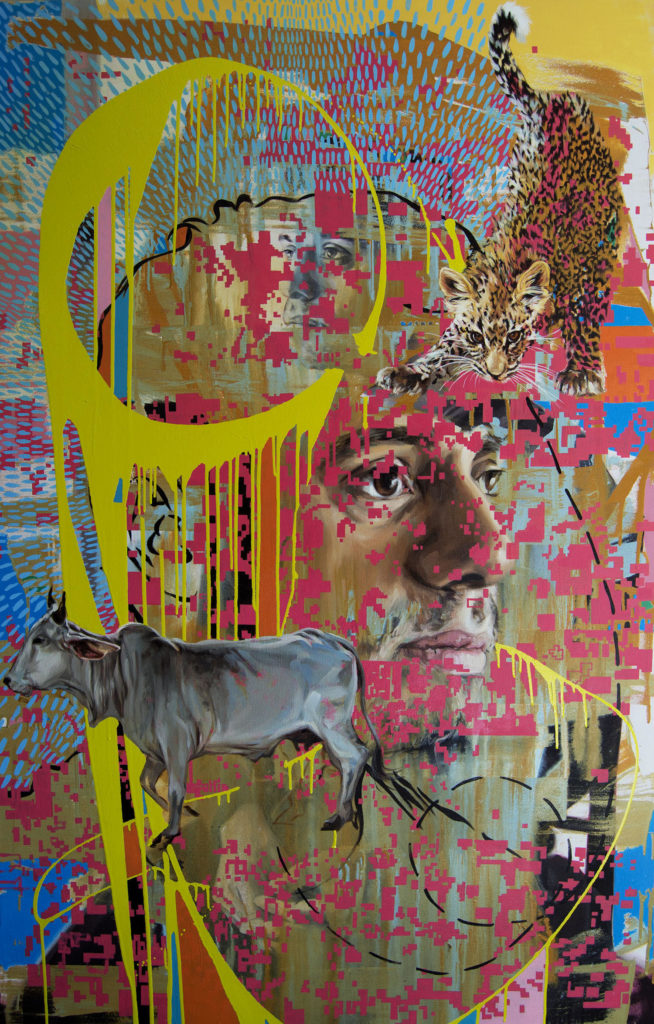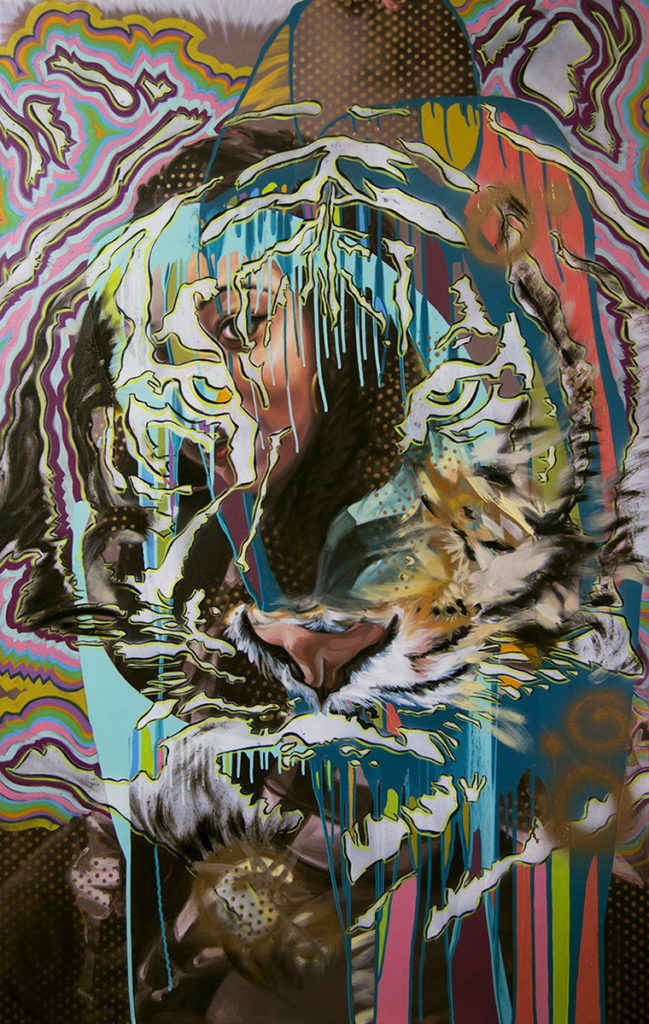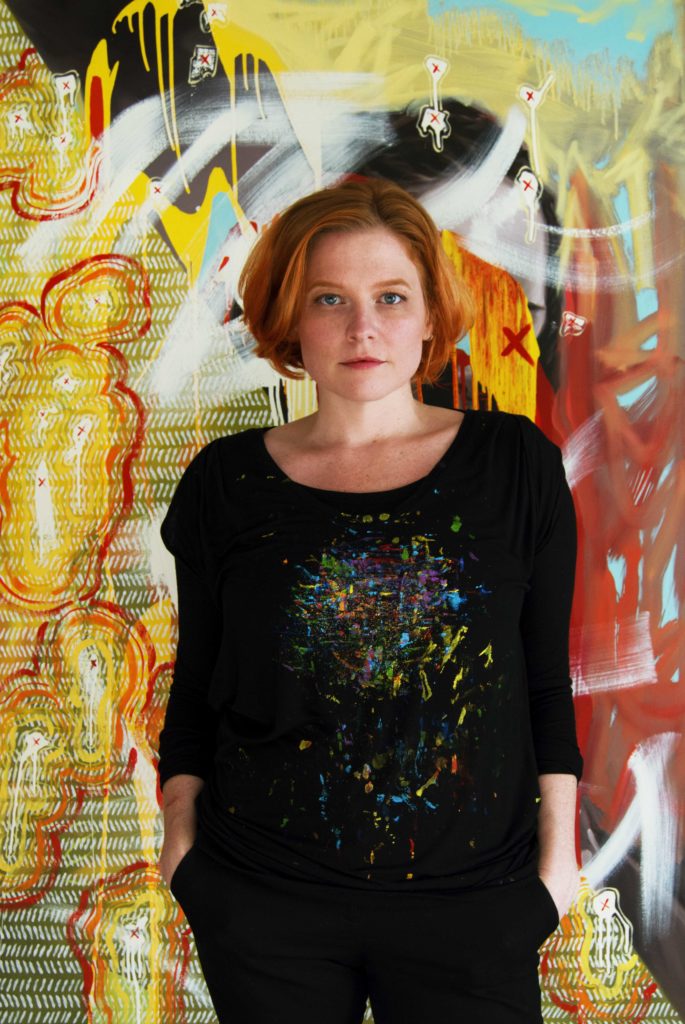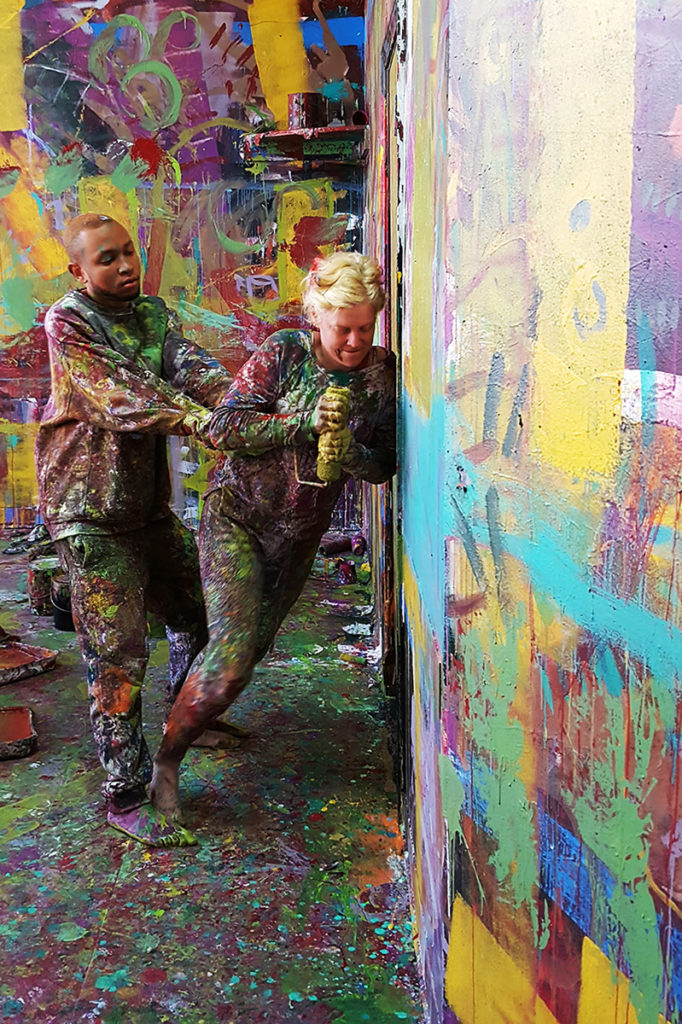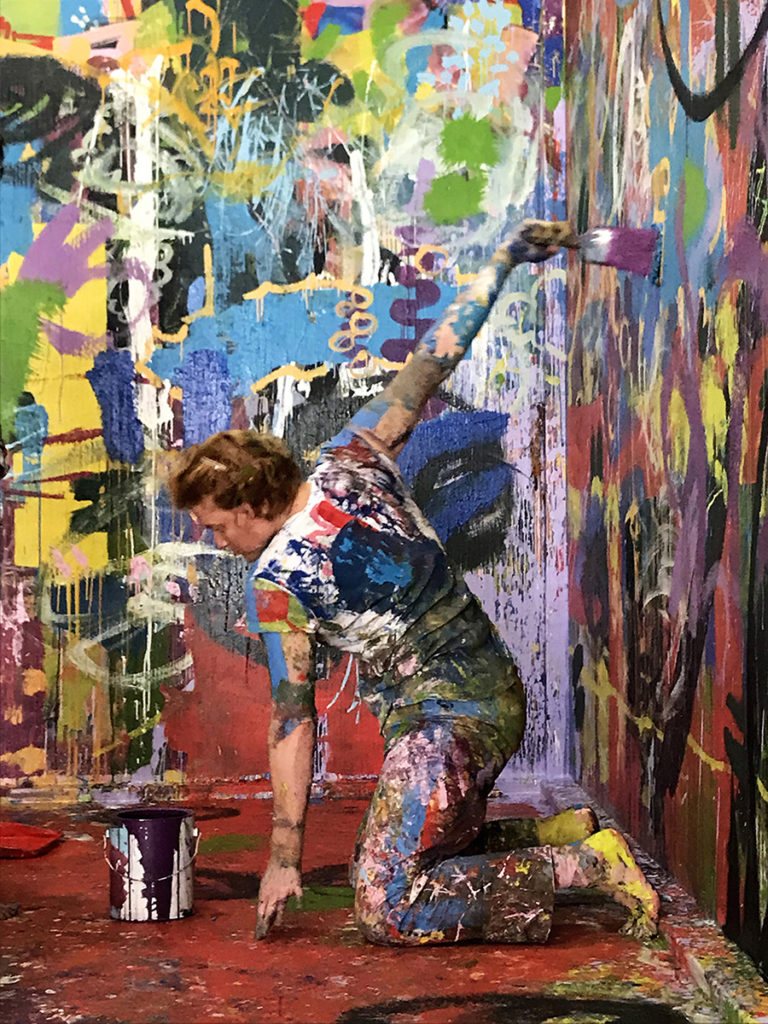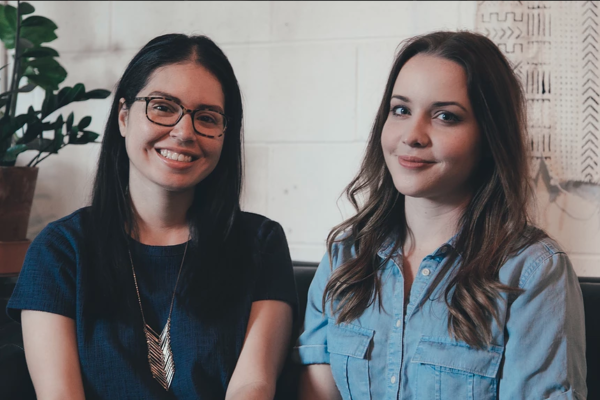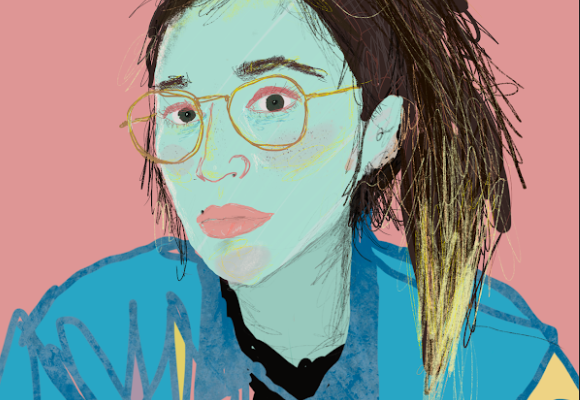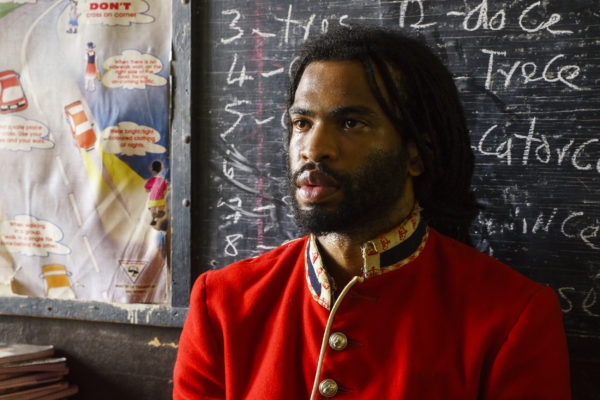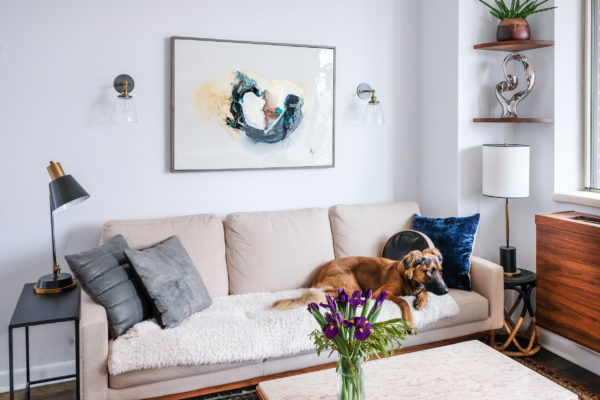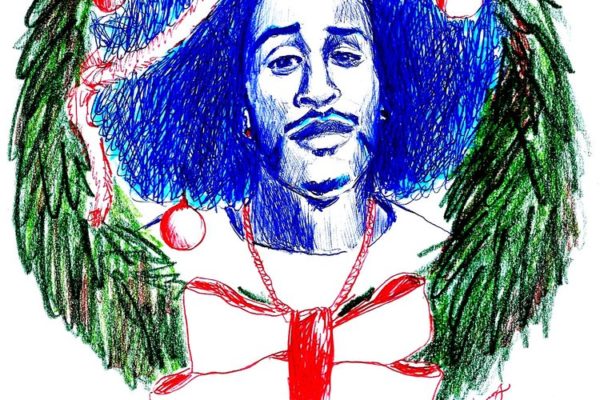Controlled chaos: That’s how Atlanta artist Amanda Grae Platner describes her style. Part of her work’s aim is to help people around Atlanta and beyond — possibly including you.
Platner says her work involves dealing with things that can’t be controlled – and that’s OK. She’s trying to make it a little easier for us to accept those challenges. Not only are gender, race, birthplace and socioeconomic status out of our control, but so are outside items like our health, other people, and the weather. Now, after realizing this about her work, she is hoping that her audience can have the same experience too.
Here, Platner explains to CommonCreativATL why art is like a virus to her, her greatest motivation, and the life-changing diagnosis that had her diving right into the paint.
CommonCreativ: What sparked your interest in art?
Amanda Grae Platner: I don’t think I could point to one thing that sparked my interest. Art has always been part of my life. It’s like food. Without it I’d lack the fuel to keep going. I have an extremely creative family. I grew up surrounded by the act of making. Drawing, painting, sculpting, sign painting, storytelling, stained glass, knitting, sewing, crafting of all kinds. It’s a never-ending list.
I have an aunt that had a huge influence on me. I spent a lot of time with her during a difficult period in my childhood. She wrote children’s stories and made illustrations of the characters. She would make these character drawings in blue ballpoint pen on lined notebook paper, then cut them out. She had a shoebox full of these little characters. I would open the box and gently look over each little drawing. The ink was so thick that it warped the paper, and some of the cutouts were so small, they were fragile little treasures, tiny portals to new worlds. She had a way of turning normal things into magical things, it was something I needed as a kid — a bit of freedom when things are rough. Art has always given me hope, and a place to go. I really don’t know how anyone lives without it, because I can’t.
CC: What helped you decide to pursue art as a serious endeavor?
AGP: I don’t have a choice, it’s inside me like a virus. I think life would be much easier with an average steady career, but it’s just not who I am. It’s probably because I’m stubborn, but I can’t imagine doing anything else.
There was definitely a switch from daydreaming about being artist and actually taking it seriously. A few years back, I was diagnosed with a chronic health condition. It’s been a huge adjustment. It was one of those life-changing events everyone has at some point. It made me rethink everything about my life and the direction I want to be heading in. I abhor wasting time now, and taking action to make things happen is more important than ever. I feel like time and energy are so precious, and being privileged enough to be an artist isn’t something to be taken lightly. I’m so humbled to have had conversations with dozens of people that felt inspired by the work I’ve created, that’s everything to me. I can’t think of a better motivator. If I have the ability to create work that touches people, how can I not take that seriously? I’m so grateful that I get to be an artist.
CC: What do you want your art to communicate?
AGP: I’d like my art to communicate hope. I might challenge myself by having paint thrown on a finished painting, losing work that’s been labored over, or a performance that’s so physically challenging that the action cannot be completely controlled. All these challenges enhance the work, and our personal challenges can make us better too. At least that’s what I like to believe, that’s the hope.
CC: Do you approach working with different mediums in different ways?
AGP: I always use paint. The type of paint isn’t extremely important, though I prefer oil paint when doing representational work, and enamel when I’m throwing paint — it flows so nicely. I strongly believe in striving to master a craft. That dedication and hard work can give more than it takes. Painting just happens to be the craft I choose to dedicate myself to. The choice to continue to work with paint comes from that idea of dedication.
Having a skill to work on, to focus on improvement is essential to making it through the day. It’s the control in the uncontrollable. When I decided to use my body to work with these challenges through performance art, paint was a natural addition to that work. When I’m doing an endurance performance, having paint as an element represents that passion. It’s the thing that helps me make it through the day.
CC: What have been some of your greatest personal achievements as an artist?
AGP: I think my greatest personal achievement was developing confidence with my work. That takes a while, or it took me a while. The first time I had paint thrown on one of my finished paintings, it was a little scary. I had no idea what to expect, but now I know I can make something better when I let these uncontrollable things happen. In my first endurance performance, I walked around in a circle for 16 hours dipping my feet in a different colored paint every hour, the result was a beautiful painted path. But before I did the piece I was convinced that this was going to be the stupidest thing I’d ever done. I trust myself more now. I still often think, “This is the stupidest thing I’ve ever done,” but now I’m confident that it’s going to work out well anyway.
CC: As an artist, how do you effectively promote yourself?
AGP: Promotion is still something I’m working on improving. Networking is hands-down the best way to promote your artwork, which means showing up to openings and chatting with other artists and art enthusiasts. The most important opportunities I’ve had come from networking. It’s my weakness though. My time is so limited that I often cut shows out of my schedule to have more time for making, but I’m becoming more and more aware of the drawbacks of this choice. I really like Instagram too, it’s by far my favorite social media app. It’s perfect for visual artists — it keeps you on view when you’re not on view in real life.
CC: What project or piece are you most proud of creating?
AGP: I am most proud of Bipartisan (Work Week Performance). The Work Week Performance is an ongoing series of collaborative performances where artists live in the gallery and work 16 hours a day for five consecutive days. There is no verbal communication between the artists for the entire week. They do not discuss the process or the desired outcome, agreeing to work toward a successful piece. For each artist the choice of material, and tool, is made by the other artists. During a turn, one artist will consider what they would like the next mark to be, prepares a tool — for example, load a paintbrush with paint — then hand it to the next artist to create the mark.
Bipartisan was the first week-long performance. It was a collaboration with fellow Atlanta artist Hasani Sahlehe, we performed this piece last February at The Downtown Players Club. Other than being the first of the series, in comparison to the other piece, it became clear that the connection to the work, and the non-verbal language that was created between Hasani and I was extremely unique. We developed this strange primitive communication that was completely based in visual art. I felt more myself in that week than at any other time in my life. Now I’m trying to find a way to do it again. Hasani and I would like to explore this connection with this work again. I think we just scratched the surface of what could come out of working this way. Ideally, I’d love to perform this in a museum setting, living and working on view for a full month. That’s my big goal right now.
CC: Do you have any projects or shows in the works?
AGP: Other than my continued painting practice, I’m in a place of planning right now. I’m working on plans for a solo show [this year]. I want to make paintings that are bigger than the space I currently work in, so I’m focused on logistics planning. I’ve been applying to residences, and hopefully one of those will pan out and allow me to create in a less limited way. My goal for 2018 is to double down on the business side of my practice. I’m working on setting new goals and creating a clear plan.
CC: What are your thoughts on Atlanta, and particularly on its arts scene?
AGP: Atlanta’s art scene is extremely diverse, which is always a great thing. It seems like there’s a place in the city for all types and all levels of art making. We have the pull to bring in world-class established artists, and a huge interest in small venues that are accessible to artists just starting out. Both are essential. There’s a big interest in supporting emerging artists with organizations like MINT and Hambidge. There are great art schools like SCAD and Georgia State, they keep things fresh and full of new ideas. It seems like there are always opportunities to get involves and put your work out there. I love all the DIY galleries that are open to more experimental work, they let artists take chances and keep the scene vibrant. Atlanta is growing and along with it the art scene is growing. It’s an exciting thing to be a part of.
CC: What is it about Atlanta that you love?
AGP: I love that Atlanta is a small-big city. It feels like it’s going through a growth spurt right now, so getting involved has the potential to really shape what Atlanta will become.
CC: Who are some of your favorite artist in Atlanta?
AGP: Atlanta is so full of extremely talented artists, I could never really have a favorite. My favorite artists are those that I’ve worked with that are clearly striving to better themselves and the Atlanta art culture, I love a hard worker. The most impressive “get things done” Atlantan I’ve met is Miranda Kyle. Miranda was the curator at The Downtown Players Club, and now she’s working in Arts & Culture development for the BeltLine. Being around her while she’s discussing art is delightful. She is endlessly insightful. There’s also some great photography coming out of Atlanta right now, photographer Rose Smith has been on fire with her work about our city and the issue of gentrification. I’m also always impressed with the dedication and philosophy of Lynx Nguyen’s work. These are some of the people who inspire me and keep me wanting to do more and be better.
See more of Amanda’s work on her portfolio site and Instagram.

